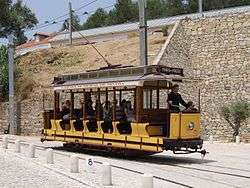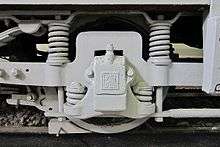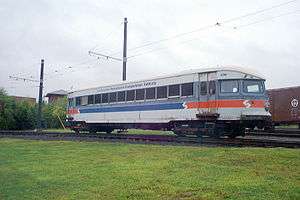J. G. Brill Company
 | |
| Privately held company | |
| Industry | Rail transport |
| Genre | Public transport |
| Founded | 1868 |
| Founder | John George Brill |
| Defunct | 1954 |
| Headquarters | Philadelphia, Pennsylvania, United States |
| Products | Streetcars (trams), interurban railcars, motor buses, and trolleybuses |


The J.G. Brill Company manufactured trams/streetcars (also, US: trolleys, trolley cars)[1], interurban coaches, motor buses, trolleybuses and railroad cars in the United States for almost ninety years; it was the longest lasting trolley and interurban manufacturer. At its height, Brill was the largest manufacturer of streetcars and interurban cars in the US and produced more streetcars, interurbans and gas-electric cars than any other manufacturer, building more than 45,000 streetcars alone.
The company was founded by John George Brill in 1868 as a horsecar manufacturing firm in Philadelphia. Over the years it absorbed numerous other manufacturers of trolleys and interurbans such as Kuhlman in Cleveland and Jewett in Indiana. In 1944, with business diminishing, it merged with the American Car and Foundry Company (ACF) to become ACF-Brill. Although the company ceased production in 1954, some of its interurbans served the Philadelphia area till the 1980s.
History
In 1868 the Brill company was founded as J.G. Brill and Sons. After James Rawle joined the firm in 1872 it was renamed The J.G. Brill Company.[2]

In 1902 Brill bought out the American Car Company; in 1904 G. C. Kuhlman Car Company and John Stephenson Company; and in 1907 Wason Manufacturing Company. Brill acquired a controlling share of the Danville Car Company in 1908, dissolving it in 1911, and Canadian railway car builder Preston Car Company in 1921, which ceased operating in 1923. In 1926 American Car and Foundry Company acquired a controlling interest in what had become the Brill Corporation. The new structure consisted of:
- ACF Motors Company, which owned Hall-Scott Motor Car Company (100%) and controlled 90% of Fageol Motors; and
- the J.G. Brill Company.[2]
In 1944 these two companies merged, forming the ACF-Brill Motors Company.[3]
In the same year, ACF-Brill licensed Canadian Car and Foundry of Montreal to manufacture and sell throughout Canada motor buses and trolley coaches of their design as Canadian Car-Brill. The firm built about 1,100 trolley buses and a few thousand buses under the name. Brill had earlier (in 1908) established a company in France (Cie. J.G. Brill of Gallardon, which was sold to Electroforge in 1935.[2]
In 1946 Consolidated Vultee Aircraft Corporation acquired a controlling interest in ACF-Brill for $7.5 million. Consolidated Vultee was sold the following year to the Nashville Corporation, which in 1951 sold its share to investment firm Allen & Co. In early 1954, the Brill name disappeared when ACF-Brill ceased production and subcontracted its remaining orders.[4]
Brill granted licenses to build its vehicles to the Canadian Car and Foundry (Peter Witt streetcars, trolley buses and motor buses) and the South Australian Railways (Model 75 railcars).
Products
- Fageol/Brill Twin Coach 44S.

- Birney safety car – by subsidiary, the American Car Company.
- Traditional arch-windowed, all-wood interurban cars. 1890-1920s.
- Model 55 (1924–38), Model 65 (1924) and Model 75 (1924–) railcars. Almost 300 were built for US and foreign railroads. A major purchaser was the South Australian Railways, which bought 12 Model 55 power cars plus trailers in 1924, followed in 1928 by 39 Model 75 power cars (all but the first being constructed in South Australia at the Islington Railway Workshops) plus trailers. The last was withdrawn from service in 1971.[2][5][6]
- Steel heavy interurban cars built 1920-1930s. The Brill "Center Door" car was typical of suburban trolleys and interurbans built around 1920. These tended to be large, heavy, double-ended cars, with passengers entering and exiting via doors located at the center of the car. Many rebuilt into one man cars.[7]
- Brill "Master Unit," built 1930s. All-steel; had standard controller stand, capable of 70 mph.[p86-100]
- Brilliner – Brill's competitor to the PCC (Presidents' Conference Committee) car looked somewhat like the first PCCs. The Brilliner was not successful when compared to the PCC. Underpowered. Few were sold, whereas PCCs were well sold worldwide. Twenty-four built for Atlantic City's Miss America Fleet.[7]
- Brill "Bullet" car, 1929–1932. For suburban/interurban use.[7]
- Brill diners – Brill sold and designed diners, generally through one of its four subsidiaries, the Wason Manufacturing Company. The last one believed to be operating is the Capitol Diner in Lynn, Massachusetts, which is listed on the National Register of Historic Places.
- Peter Witt streetcar
- Large cars with trailers
- Small cars
- Numerous models of trolleybuses, including T30, T40, 40SMT, 44SMT and, as ACF-Brill, TC44 and T46/TC46
- C-36 city bus
- IC-41 intercity bus
Bullet interurban cars

The lines that operated interurban passenger cars recognized in the mid-1920s that they needed faster, quieter, more power-efficient equipment. Until then, the wooden and most of the steel interurban cars were large, sat high, and were heavy. Streetcars were slow, noisy, and clumsy to operate using the motor controller "stand" of the time. Car manufacturers such as Cincinnati Car Co. (who already in 1922 made a lightweight, albeit slow, interurban), St. Louis Car Co., Pullman, and Brill worked to design equipment for a better ride at high speed, improved passenger comfort, and reduced power consumption. This particularly involved designing low-level trucks (bogies) able to handle rough track at speed. Brill, in conjunction with Westinghouse and General Electric, worked on a new interurban design and on a new streetcar design (the PCC).
The interurban design result was the aluminum and steel wind tunnel-(the first in the railway industry) developed slope roof "Bullet" MU cars, the first of which were purchased in 1931 by the Philadelphia and Western Railroad, a third-rail line running from 69th Street Upper Darby to Norristown in the Philadelphia region.[4] This line still runs as SEPTA's Norristown High Speed Line. The Bullets could attain speeds as high as 92 mph (148 km/h).[8] They were very successful, and operated until the 1980s, but Brill sold few others. Only the central New York state interurban Fonda, Johnstown, and Gloversville Railroad ordered Bullets, albeit a single-ended, single-unit "trolley-ized" version. Five were procured in mid-Depression 1932 for passenger business that was rapidly declining. In 1936, the closing FJ&G sold these Bullets to the Bamberger Railroad in Utah, which ran them in high-speed service between Salt Lake City and Ogden until the mid-1950s.[2]
Three of the SEPTA Bullet cars are now at the Seashore Trolley Museum, one is at the Electric City Trolley Museum in Scranton, one is at the Rockhill Trolley Museum in Orbisonia PA, one is at the National Museum of Transportation in St. Louis MO, and one is at the Pennsylvania Trolley Museum in E. Washington. A Bamberger Bullet is in the Orange Empire Railroad Museum in Perris, California, and another has been preserved by the Utah State Railroad Museum. A third is a part of a restaurant building in Springville, Utah, but is barely recognizable as a Bullet.
Brill look-alike cars in the 2010s
Since 2015 the JR Kyushu, one of the constituent companies of Japan Railways Group, has operated the Aru Ressha "sweet train", a deluxe excursion train. It comprises two power cars and two newly built trailer cars based on a luxury Brill car the railway ordered in 1908 but never used. Scale models of the original cars were used to derive the design.
See also
References
- ↑ Young, Andrew D. (1997). Veteran & Vintage Transit, p. 101. St. Louis: Archway Publishing. ISBN 0-9647279-2-7
- 1 2 3 4 5 Brill, Debra (August 2001). History of the J.G. Brill Company (Series: Railroads Past and Present). Indiana University Press. ISBN 0253339499.
- ↑ Sebree, Mac; and Ward, Paul (1973). Transit's Stepchild: The Trolley Coach, p. 127. Los Angeles: Interurbans. LCCN 73-84356.
- 1 2 "The J.G. Brill Company". American-Rails.com. Retrieved 2016-02-23.
- ↑ "[Exhibit 60: 55 class railcar] 8 South Australian Railways – Broad Gauge". National Railway Museum. National Railway Museum Incorporated. November 2017. Retrieved 30 November 2017.
- ↑ "[Exhibit 61: 75 class railcar] R.C. 41 South Australian Railways – Broad Gauge". National Railway Museum. National Railway Museum Incorporated. November 2017. Retrieved 30 November 2017.
- 1 2 3 Springirth, Kenneth C. (2007). Suburban Philadelphia Trolleys. Charleston: Arcadia Publishing. ISBN 9780738550435.
- ↑ Middleton, William D. (1965). The Interurban Era. Milwaukee: Kalmbach Publishing Company. ISBN 9780890240038.
Bibliography
- Middleton, William D. The Interurban Era, Kalmbach Publishing Company, Milwaukee, 2000 [1965]. ISBN 9780890240038. (Coverage: list of US interurban car manufacturers, pp 416–417; Bullet design, pp 68-70.)
- Volkmer, William D. Pennsylvania Trolleys in Color, Morning Sun Books, Scotch Plains, 1998. Vol. 2. ISBN 978-1878887993. (Coverage: photographs of Brilliners, Bullets and other Brill designs, on Philadelphia and Western line and in shops.)
- Hilton, George W. & Due, John F. The Electric Interurban Railways in America, Stanford University Press, Stanford, reissue 2000. ISBN 9780804740142. (Coverage: development of improved interurban car design.)
- Springirth, Kenneth C. Suburban Philadelphia Trolleys, Arcadia Publishing, Charleston, 2007. ISBN 9780738550435. (Coverage: development of Bullet design.)
- Bradford, Francis H. & Dias, Ric A. Hall-Scott: the untold story of a great American engine maker, SAE International Book Publishing, Warrendale, 2007. ISBN 9780768016604.
External links
| Wikimedia Commons has media related to Brill vehicles. |
- History of J.G. Brill Company
- The J.G. Brill Company Records, including approximately 16,000 photographs, are available for research use at the Historical Society of Pennsylvania.
- Brill Bullet
- Photos of Red Arrow Trolleys, including Brill cars
- Brill history and photos
- The Tramways of Colombia